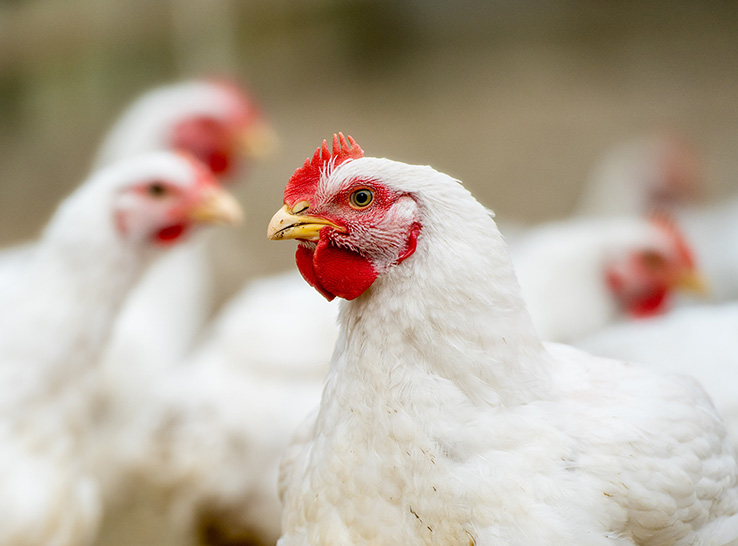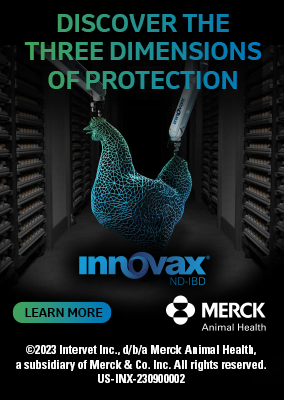 Poultry farms seeking protection against infectious laryngotracheitis (ILT) outbreaks may find the best defense for layers and broiler-breeder replacement birds is a dual ILT vaccination program.
Poultry farms seeking protection against infectious laryngotracheitis (ILT) outbreaks may find the best defense for layers and broiler-breeder replacement birds is a dual ILT vaccination program.
“Vaccination programs that include administration of recombinant ILT vaccine at the hatchery followed by live attenuated vaccines tissue-culture origin (TCO) applied in the field have been shown to provide optimal protection against ILT in multi-age layer and broiler-breeder replacement birds,”1,2 says Ivan Alvarado, DVM, PhD, associate director of scientific marketing affairs for poultry at Merck Animal Health.
One recent study examined the protection levels of three vaccination programs using two Merck Animal Health vaccines against an ILT challenge:
- Innovax®-ND-ILT, which may be administered in ovo to 18-day-old chicken embryos or subcutaneously to day-old chicks, provides protection against Marek’s disease, Newcastle disease and ILT. This recombinant vaccine consists of the serotype 3 herpesvirus of turkey (HVT) containing genes for ILT glycoprotein D and I genes from the ILT virus, along with the ND fusion gene. (Its sister products include the original Innovax®-ILT and the just-released Innovax®-ILT-IBD, which also protects against infectious bursal disease virus.)
- LT-Ivax® is a live-virus vaccine containing a carefully selected ILT virus strain modified by passage in tissue culture. This vaccine contains a highly attenuated virus, which has been shown to be safe and effective for the vaccination of healthy chickens 4 weeks of age or older against infectious fowl laryngotracheitis.
Study set-up
Conducted at the University of Georgia, the study investigated protection provided by the two vaccines against a virulent ILT challenge at 15 weeks of age.
For the study, investigators used specific pathogen-free Leghorn chicken eggs from a commercial source. At hatch, they randomly distributed 107 chicks among five treatment groups:
- Group 1: Vaccinated with Innovax-ND-ILT by subcutaneous injection at day 1;
- Group 2: Received LT-IVAX by eye drop at 10 weeks of age;
- Group 3: Received both vaccines at the same age and administration method as the first two groups;
- Group 4: Unvaccinated and challenged;
- Group 5: Unvaccinated with no ILT challenge so investigators could monitor birds for background infections.
At 15 weeks, investigators challenged chicks in Groups 1-4 with a highly virulent ILT virus strain and then evaluated them for clinical signs of ILT. They also used tracheal swabs to monitor ILT’s presence.
Strong ILT protection
Survival rates were high for all three vaccinated groups after ILT challenge, including 100% survival in the dual-vaccinated (Group 3), 95% for birds vaccinated with the Innovax-ND-ILT only (Group 1) and 87% for flocks vaccinated only with LT-Ivax (Group 2). In comparison, only 40% of the unvaccinated ILT-challenge group survived.
The three vaccination programs provided significant protection against clinical signs of ILT compared to the unvaccinated control group (Group 4). The dual-vaccinated birds in group 3 showed the lowest clinical signs, similar to the non-challenged birds in Group 5.
Birds receiving both ILT vaccines also showed the greatest reduction in viral shedding and horizontal transmission. The two single-vaccinated groups also showed some reduction in shedding.
“The three vaccination programs evaluated in this study showed reduced clinical signs, reduced mean viral-load shedding and good survival rates post-challenge at 15 weeks of age,” Alvarado says.
“The most robust protection against virulent ILT challenge was observed in birds that received the dual-vaccination program (Group 3). These birds exhibited not only the best protection against clinical signs and mortality, but also a drastic reduction of viral shedding post challenge, preventing horizontal transmission to naïve birds,” he adds.
ILT prevalent, virulent
ILT is an economically important respiratory disease affecting the poultry industry worldwide.3
Recently, the virus has become more prevalent and is circulating rapidly.4 ILT outbreaks tested at the University of Georgia indicated one virulent genotype was moving fast, with numbers doubling from 2022 to 2023. Early 2024 positive cases indicated even more outbreaks were expected for the year.
In a severe presentation, ILT causes gasping, expectoration of bloody mucus and high mortality due to asphyxia, Alvarado explains. “Biosecurity and vaccination are the pillars of successful ILT-control programs,”5,6he adds.
Vaccination programs rely on the use of live, modified attenuated vaccines produced through chicken-embryo (CEO) or tissue-culture origin (TCO), and recombinant vaccines using HVT as a vector to express ILT virus immunogenic proteins.7
TCO vaccines provide protection against respiratory signs and mortality associated with ILT, and reduce replication and shedding of field-challenge strains.
Unlike CEO products, TCO vaccines are highly attenuated and do not regain virulence after bird-to-bird passage, thus inducing robust protection while limiting horizontal transmission.8
As a response to the frequent ILT outbreaks associated with CEO-related viruses, recombinant HVT expressing immunogenic ILT virus proteins (rHVT-ILT) have been increasingly used worldwide.9,10
These rHVT-ILT vaccines reduce clinical signs of the disease and maintain bird performance, but they are not as effective for reducing the shedding of challenge viruses when compared with live attenuated vaccines,11,12 Alvarado cautions.
Overall, this study showed that using recombinant ILT vaccines at the hatchery followed by live attenuated TCO vaccines in the field provides optimal protection against ILT in long-lived birds.
1 Maekawa D, Beltrán G, Riblet SM, et al. Protection efficacy of a recombinant herpesvirus of turkey vaccine against infectious laryngotracheitis virus administered in ovo to broilers at three standardized doses. Avian Dis. 2019;63:351-358.
2 Maekawa D, Riblet SM, Newman L, et al. Evaluation of vaccination against infectious laryngotracheitis (ILT) with recombinant herpesvirus of turkey (rHVT-LT) and chicken embryo origin (CEO) vaccines applied alone or in combination. Avian Path. 2019; 48:573-581.
3 Davison AJ, Eberle R, Hayward GS, et al. The order Herpesvirales. Arch Virol. 2009;154:171-177.
4 Pathologist: ILT genotype growing more prominent and virulent in poultry. Modern Poultry. 2024. https://modernpoultry.media/uga-pathologist-fast-spreading-ilt-virus-growing-more-prominent-virulent-in-poultry/?mp=1710782985207 (Accessed: Mar. 18, 2024).
5 Maekawa D, Beltrán G, Riblet SM, et al. Protection efficacy of a recombinant herpesvirus of turkey vaccine against infectious laryngotracheitis virus
6 Guy JS, García M. Infectious laryngotracheitis virus. In: Diseases of Poultry, 12th ed. Saif YM, Glisson JR, Fadly AM, et al. eds. Wiley-Blackwell, Hoboken, NJ, 2008. p 137-152.
7 García M, Zavala G. Commercial vaccines and vaccination strategies against infectious laryngotracheitis: what we have learned and knowledge gaps that remain. Avian Dis. 2019;63:325-334.
8 Guy JS, Barnes HJ, Smith L. Increased virulence of modified-live infectious laryngotracheitis vaccine virus following bird-to-bird passage. Avian Dis. 1991;35:348-355.
9 Maekawa D, Beltrán G, Riblet SM, et al. Protection efficacy of a recombinant herpesvirus of turkey vaccine against infectious laryngotracheitis virus administered in ovo to broilers at three standardized doses.
10 Esaki M, Noland L, Eddins T, et al. Safety and efficacy of a turkey herpesvirus vector laryngotracheitis vaccine for chickens. Avian Dis 2013; 57:192-198.
11 García M, Zavala G. Commercial vaccines and vaccination strategies against infectious laryngotracheitis.
12 Gimeno IM, Cortes A, Guy J, et al. Replication of recombinant herpesvirus of turkey expressing genes of infectious laryngotracheitis virus in specific pathogen free and broiler chickens following in ovo and subcutaneous vaccination. Avian Pathol. 2011;40:395-403.









